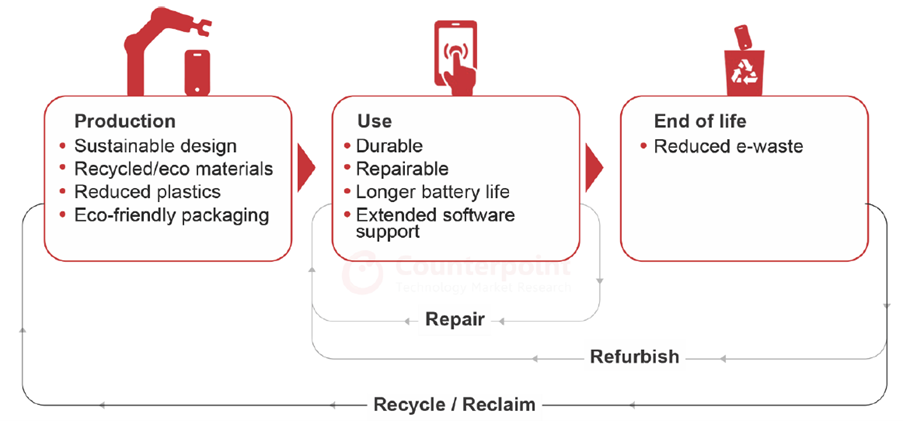Trends
Samsung Sustainability Report: Good progress made, a bit more needed
The 2023 report is much more focused and only contains information directly relevant to device circularity. For example, it has sub-sections on the use of recycled/recyclable materials, extending product lifecycles, repairability and e-waste collection/recycling. This is much clearer and in line with Counterpoint Research’s vision of what is needed for the smartphone industry to become truly circular (see chart).

Samsung has made some good strides this year in the three key areas of a circular economy – production, use and end of life. For example:
- Samsung reported a three-fold increase in the use of recycled resin in its devices’ plastic parts in 2022 when compared to 2021.
- The Galaxy S23 series’ volume keys, side key and SIM tray are made with 28% pre-consumer aluminium scrap, and its front screen and back cover contain 22% pre-consumer recycled glass.
- The packaging box for the Galaxy S23 series is 100% recycled paper, while the plastic films which used to be attached to the front and back of the product have been replaced with 100% recycled paper.
- Reclaimed and recycled fishing nets are used in six components in the Galaxy S23 series, up from three in the S22 series.
- The Galaxy S23 series obtained the highest rating in France’s Repairability Index.
- Samsung grew its repairability network in the US.
- All Galaxy S23 series models come with four generations of OS upgrades and five years of security updates.
- 600,000 tonnes of e-waste was collected in 2022, a 9% increase on 2021.
- Samsung was the second largest OEM in the global refurbished smartphone market, accounting for 26% of sales in 2022.
- Some of these initiatives are improvements over the competition. For example, Apple’s product packaging still contains 4% plastic (although this is down from 10% in 2018) and most Chinese OEMs like Xiaomi, OPPO, vivo and HONOR still do not use any recycled material in their smartphones at all.
However, Samsung still has a lot of work to do to be seen as a true sustainability pioneer. For a start, its claims around recycled materials and repairability are limited to its flagship Galaxy S series. Samsung makes no mention of any eco-improvements in its A series of smartphones, which account for over 60% of its sales.
Similarly, Samsung’s use of 28% pre-consumer aluminium scrap in various places and 22% pre-consumer recycled glass in the back case of the Galaxy S23 series is on the modest side. By comparison, the Google Pixel 7/7 Pro features an aluminium enclosure made from 100% recycled content, Nokia X30 5G’s body is made with 100% recycled aluminium and 65% recycled plastic, and the Fairphone 4 has a 100% recycled plastic back cover.
Of course, scale is a factor. Samsung shipped 260 million smartphones in 2022, compared to 12 million by HMD (under the Nokia brand), 8 million by Google and 115,000 by Fairphone. It is already difficult making a sustainable smartphone, but it is substantially harder to scale up such achievements when you are the world’s biggest smartphone manufacturer. Having said that, a company such as Samsung should be aiming for leadership, not being second best.
Finally, there is Samsung’s famous use of reclaimed old fishing nets and other ocean-bound plastics in the production of its latest smartphones. The recycled materials are only used in a small number of components in each model. Not exactly an impressive achievement. Also, Samsung claims that by the end of 2022, its use of recycled ocean-bound material has prevented more than 50 tonnes of discarded fishing nets from entering the world’s oceans. This is less than 0.01% of the estimated 640,000 tonnes discarded each year. Yes, great initiatives, but are they enough?
Overall, Samsung has made good progress over the last year. Not as much as is needed to become a sustainability leader but, of course, any progress made towards making the smartphone industry less environmentally destructive should be applauded and encouraged. Samsung needs to be careful, though, that its big marketing campaigns, particularly those lauding its recovery of discarded fishing nets, don’t cross into greenwashing territory. Counterpoint Research












You must be logged in to post a comment Login